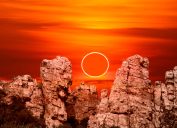One of the Brightest Stars Will Briefly Disappear Next Week—How to See It Happen
The highly unusual event will only take place for 12 seconds, so make sure you don't miss it.

It isn't every day that the skies above treat us ground dwellers to a dazzling light show. This year, we've been gifted with colorful meteor showers on more than one occasion—but Mother Nature has another trick up her sleeve before 2023 comes to a close. According to Sky & Telescope, next week stargazers and constellation chasers will have the chance to witness a very rare event in the sky, as Betelgeuse, one of the brightest stars, will temporarily disappear.
RELATED: 2023's Best Meteor Shower Lights Up the Sky This Week—How to See It.
The red supergiant star will "briefly blink off" when it becomes "occulted" (or blocked) by the asteroid 319 Leona, as explained by Live Science. Betelgeuse can be spotted on the right shoulder of Orion, and is considered the constellation's second-brightest star, as well as the 10th brightest star in the atmosphere.
The highly unusual event will only last 12 seconds, and is expected to occur on Monday, Dec. 11, around 8:17 p.m. EST, according to Sky & Telescope.
Additionally, only certain onlookers along a very narrow path "stretching from Asia to southern Europe, Florida, and eastern Mexico" will be able to observe the blink-out without binoculars or a telescope, per Live Science. However, thanks to The Virtual Telescope Project, you can also watch the event unfold in real time via livestream.
The organization, which is based in Italy and will have a perfect viewing of the show, will begin the livestream at 8 p.m. EST on Dec. 11. Meanwhile, the occultation's visibility trail can be downloaded on the International Occultation Timing Association's website.
In order to locate Betelgeuse in the night sky from the Northern Hemisphere, you'll want to be facing due east about two hours after sundown, as instructed by Live Science. The trio of stars in Orion's Belt will be the easiest to spot first: Alnitak, Alnilam, and Mintaka. Betelgeuse can be seen on the same horizon line as Mintaka, to the left.
Betelgeuse's brief disappearance won't just be exciting for us to witness—it will also have practical applications for astronomers. Experts are hoping to learn more about Betelgeuse's surface, as well as the shape and size of asteroid 319 Leona.
"These kind of occultations are very useful to constrain the shape of the asteroid involved," Gianluca Masi, an astrophysicist and director of The Virtual Telescope Project, said in a statement.
"We will be hopefully able to learn more about its large convective cells, which is driving its variable brightness," Masi concluded.
RELATED: For more up-to-date information, sign up for our daily newsletter.





















